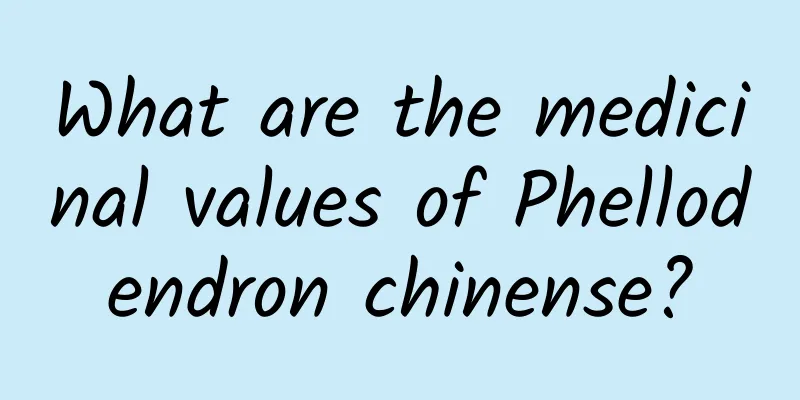What are the medicinal values of Phellodendron chinense?

|
Most people may not have heard of Huangbo. It is a medicine that is roughly similar to Coptis chinensis, but contains less Coptis chinensis. It has the effects of killing fungi, sterilization and anti-inflammatory. This medicinal material has a wide range of medicinal value and can fight chronic inflammation, such as prostatitis bacterial infection, and has a good effect on whooping cough and tetanus. Huangbo has a wide range of medicinal value and can fight various stubborn diseases. Pharmacological effects of Phellodendron chinense: 1. Antibacterial effect: The active antibacterial ingredient of Phellodendron chinense is berberine, so its pharmacological effects are generally similar to those of Coptis chinensis, but its content is lower than that of Coptis chinensis. In vitro tests were performed on Staphylococcus aureus, Pneumococcus, Corynebacterium diphtheriae, Streptococcus viridans, Shigella dysenteriae (except Sonnei), hemolytic Streptococcus, meningococcus, and Vibrio cholerae. It has an effective or strong inhibitory effect on Bacillus anthracis; it also has an inhibitory effect on Bacillus subtilis, Bordetella pertussis, and Bordetella tetani; it has no direct inhibitory effect on H37Rv and avian Mycobacterium tuberculosis, but can reduce the number of bacteria. However, it shows an inhibitory effect when the concentration reaches 1%. When guinea pigs were inoculated with human tuberculosis (H37Rv) for experimental treatment, the efficacy of oral or injection treatment was very poor. For guinea pigs inoculated with bovine tuberculosis, the hydrochloride crystals of Phellodendron amurense extract have a certain therapeutic effect when injected intramuscularly. Huangbai improves the clinical symptoms and X-ray examinations of tuberculosis patients, and is superior to Huanglian. In test tubes, decoction or infusion of Phellodendron chinense had different degrees of antibacterial effects on common pathogenic fungi. Its decoction cannot kill Leptospira (the dosage needs to be 1 times larger than that of Coptis chinensis). It also has a weak effect on Trichomonas vaginalis in vitro. It is reported that a 1:1 Phellodendron liquid made from the acid-base extract of Phellodendron can be used by enema to treat bacillary dysentery, which usually takes 2-4 days to heal. Huangbo therapeutic solution uses direct current introduction to treat chronic prostatitis, with an overall effective rate of 97.3%. 2. Antifungal Effect: The ether extracts of Phellodendron chinense and Phellodendron chuanxiong had strong antibacterial effects on Cryptococcus neoformans and Trichophyton rubrum, which were stronger than nystatin, but their inhibitory effects on Candida albicans were weaker than nystatin. 3. Antitussive effect: The volatilization of Phellodendron chinense fruit has an antitussive effect, and its antitussive component is mainly myrcene. Berberine and 5,5'-dimethylfurfural ether were separated from the volatile oil. 4. Antihypertensive effect: Intravenous or intraperitoneal injection of Phellodendron chinense into anesthetized animals can produce a significant and lasting antihypertensive effect. Injection into the carotid artery is stronger than that into the vein, so the antihypertensive effect may be central. Xylopinin, a tertiary amine compound synthesized by modifying the quaternary ammonium type phellodendron, can also cause a rapid and significant drop in blood pressure. The blood pressure drop disappears when the spinal cord is cut between cervical vertebrae I and II, thus proving that the blood pressure drop is central. In addition, cyroprenaline has a strong anti-adrenergic effect, inhibiting the pressor response caused by compression of the carotid artery, asphyxia, electrical stimulation of the large visceral nerves, and the nictitating membrane contraction response caused by injection of epinephrine or electrical stimulation of the superior cervical sympathetic ganglion. 5. Anti-trichomoniasis effect: Phellodendron chinense decoction, 10% concentration, mixed with Trichomonas solution in a 1:1 ratio and cultured, has an inhibitory effect on Trichomonas vaginalis. This is the end of the introduction to the medicinal value of Phellodendron chinense. Phellodendron chinense itself is rich in medicinal materials and can be eaten by both children and the elderly. It has bactericidal and anti-inflammatory effects on chronic prostatitis. Phellodendron chinense also has an anesthetic effect and a long-lasting efficacy, so it is very effective in lowering blood pressure, regulating nerves, and treating trichomoniasis. |
<<: What are the medicinal values of Scutellaria baicalensis?
>>: What are the medicinal values of Achyranthes bidentata?
Recommend
It can grow a new head even if it's missing! Why is the "Axolotl" so amazing?
If you love to visit flower and bird markets, you...
The efficacy and function of Qiongzhi
Traditional Chinese medicine often has unexpected...
The efficacy and function of water bamboo leaves
Many people know that water bamboo leaves have un...
Is this the "King of Vitamin C" among vegetables? Peppers are more than just spicy!
Tuchong Creative Vitamin C is a nutrient that eve...
How do we achieve rocket sharing when launching multiple satellites into space?
In a blink of an eye, 2023 is drawing to a close,...
Illustration Wonderland: Japanese Myths and Legends
Leviathan Press: We often say that we need to go ...
The efficacy and function of leucophylla
Chinese medicinal materials have good effects on ...
You'd never guess that plants can...
If we fast-forward a video of a plant's growt...
The efficacy and function of three-leaf golden osmanthus
Diseases require improvement through medicine. Di...
The efficacy and function of blood leaf orchid
Traditional Chinese medicine often has unexpected...
The efficacy and function of banyan tree
Ficus microcarpa is a very good medicinal herb. I...
The medicine used to treat the prince in ancient times was so magical
Many Chinese medicines have legendary histories a...
"Health from eating" series | Why does black wolfberry change color when soaked in water? Talk about the eating tips of black wolfberry
Black wolfberry, also known as black wolfberry or...
comScore: 61% of tablet users have used their devices to make travel reservations
A recent survey report shows that with the rapid ...
The efficacy and function of Houtazi
Hou'erzi is a common medicinal material in tr...









